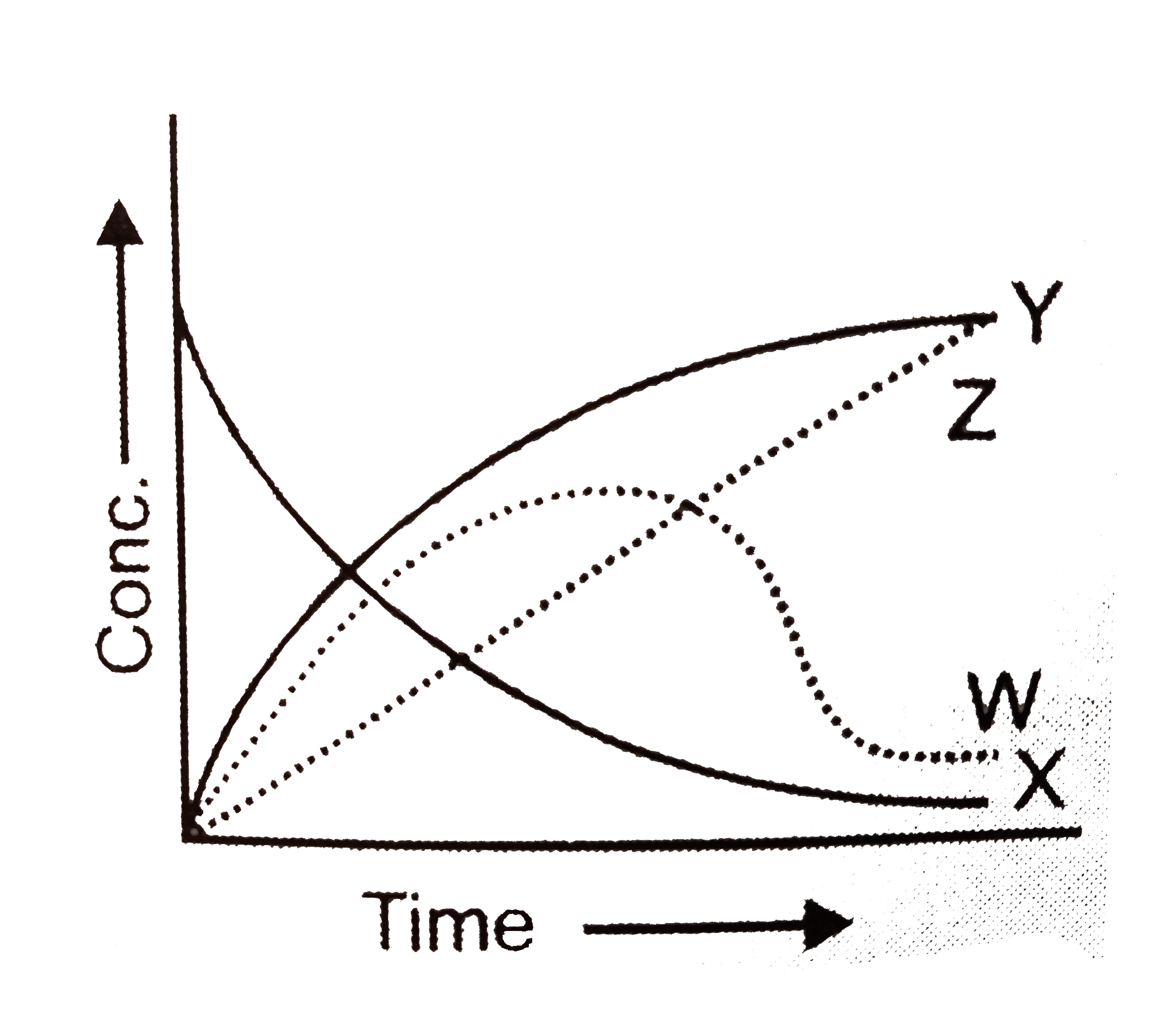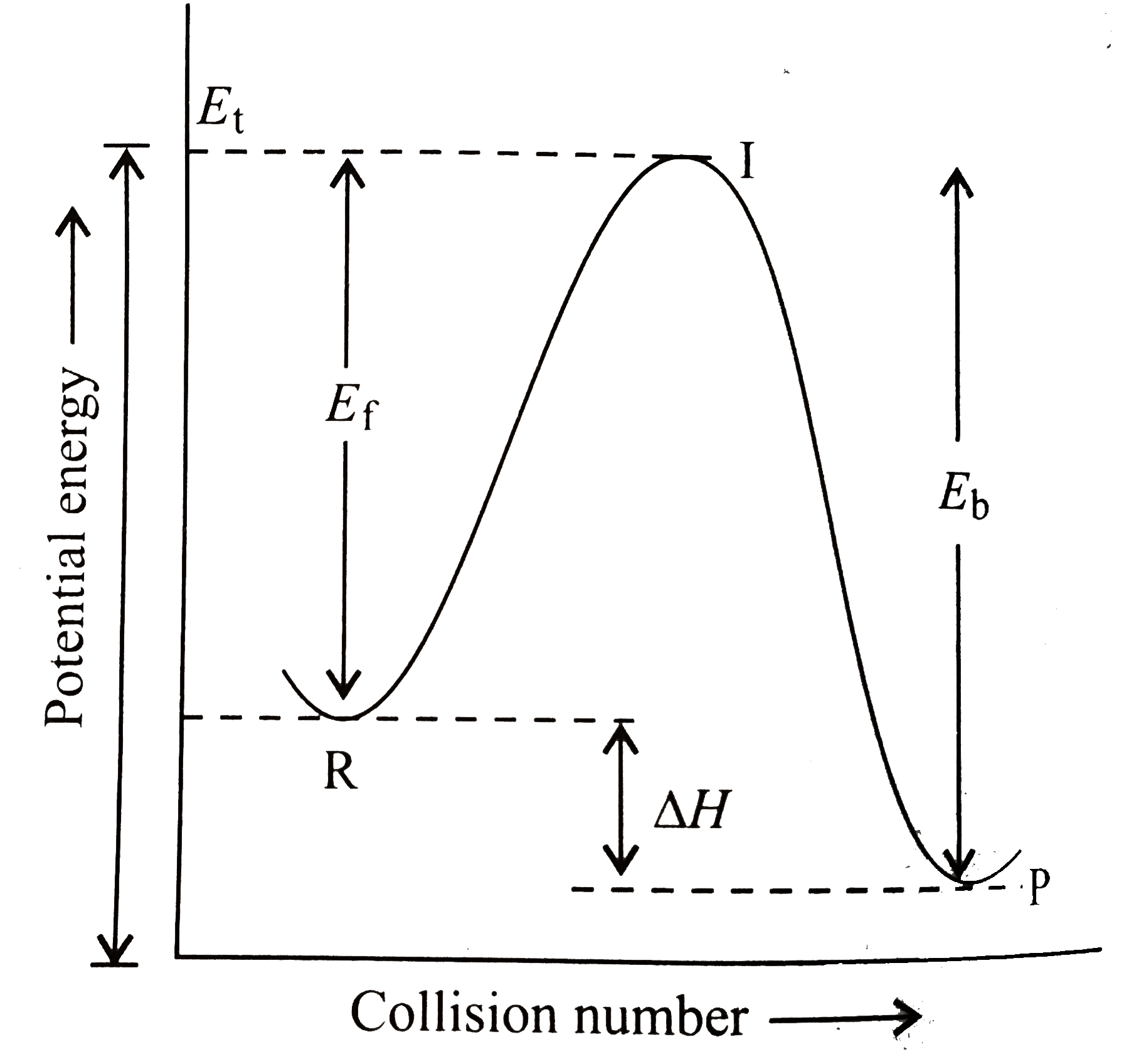The rate of reaction (dxdt) varies with nature, physical state and concentration of reactants, temperature, exposure to light and catalyst, whereas rate constant (K) varies with temperature and catalyst only. The rate constant K is given as K=Ae−Ea/RT where A is Arrhenius parameter or pre-exponential factor and Ea is energy of activation. The minimum energy required for a reaction is called threshold energy and the additional energy required by reactant molecules to attain threshold energy level is called energy of activation.
For a reaction, A→B, if
log10K(sec−1)=14−1.25×104TK, the Arrhenius parameter and energy of activation for the reaction are:
(a) 1014sec−1,239.34kJ
(b) 14,57.6kcal
(c ) 1014sec−1,23.93kJ
(d) 1014sec,5.76kcal
The correct Answer is:a
2.303log10K=2.303log10A=EaRT
∴Ea2.303R=1.25×104
∴Ea=1.25×104×2.303×8.314
=239.34×103J
logA=14∴A=1×1014
Topper's Solved these Questions
- CHEMICAL KINETICSBOOK - P BAHADURCHAPTER - CHEMICAL KINETICSEXERCISE - Exercise 1
2 Videos
- CHEMICAL KINETICSBOOK - P BAHADURCHAPTER - CHEMICAL KINETICSEXERCISE - Exercise 3A
2 Videos
- DILUTE SOLUTION AND COLLIGATIVE PROPERTIESBOOK - P BAHADURCHAPTER - DILUTE SOLUTION AND COLLIGATIVE PROPERTIESEXERCISE - Exercise 9 Advanced Numerical
12 Videos
Similar Questions
The following data represent for the decomposition of NH4NO2 in aqueous solution.
Time (in minutes), 10,15,20,25,∞
Volume of N2 (in mL), 6.25,9.0,11.40,13.65,33.05,
(a) Show that reaction is of first order.
(b) Calculate velocity constant.
View SolutionFor the reaction, A+B→C+D. The variation of the concentration of the products with time is given by the curve:

View SolutionIf at a particular tempreture, the density of 18M H2SO4 is 1.8gCm−3, calcualte:
(a) Molality,
(b) % concentration by weight of solution
(c ) Mole fraction of water and H2SO4,
(d) Relative decrease in vapour pressure with repsect to H2O solvent assuming H2SO4 almost unionised at this high concentration.
View SolutionA colliison between reactant molecules must occur with a certain minimum energy before it is effective in yielding Product molecules. This minimum energy is called activation energy Ea Large the value of activation energy, smaller the value of rate constant k. Larger is the value of activation energy, greater is the effect of temperature rise on rate constant k.

Ef= Activation energy of forward reaction
Eb= Activation energy of backward reaction
ΔH=Ef−Eb
Ef= threshold energy
For two reactions, activation energies are Ea1 and Ea2, rate constant are k1 and k2 at the same temperature. If k1>k2, then
View SolutionA colliison between reactant molecules must occur with a certain minimum energy before it is effective in yielding Product molecules. This minimum energy is called activation energy E_(a) Large the value of activation energy, smaller the value of rate constant k . Larger is the value of activation energy, greater is the effect of temperature rise on rate constant k . E_(f) = Activation energy of forward reaction E_(b) = Activation energy of backward reaction Delta H = E_(f) - E_(b) E_(f) = threshold energy The rate constant of a certain reaction is given by k = Ae^(-E_(a)//RT) (where A = Arrhenius constant). Which factor should be lowered so that the rate of reaction may increase?
View SolutionThe rate of reaction (dxdt) varies with nature, physical state and concentration of reactants, temperature, exposure to light and catalyst, whereas rate constant (K) varies with temperature and catalyst only. The rate constant K is given as K=Ae−Ea/RT where A is Arrhenius parameter or pre-exponential factor and Ea is energy of activation. The minimum energy required for a reaction is called threshold energy and the additional energy required by reactant molecules to attain threshold energy level is called energy of activation.
At what conditions exponential factor is zero a reaction?
View SolutionThe rate of reaction ((dx)/(dt)) varies with nature, physical state and concentration of reactants, temperature, exposure to light and catalyst, whereas rate constant (K) varies with temperature and catalyst only. The rate constant K is given as K=Ae^(-E_(a)//RT) where A is Arrhenius parameter or pre-exponential factor and E_(a) is energy of activation. The minimum energy required for a reaction is called threshold energy and the additional energy required by reactant molecules to attain threshold energy level is called energy of activation. For an endothermic reaction, which one is true if DeltaH is heat of reaction and E_(a) is energy of activation?
View SolutionThe rate of reaction ((dx)/(dt)) varies with nature, physical state and concentration of reactants, temperature, exposure to light and catalyst, whereas rate constant (K) varies with temperature and catalyst only. The rate constant K is given as K=Ae^(-E_(a)//RT) where A is Arrhenius parameter or pre-exponential factor and E_(a) is energy of activation. The minimum energy required for a reaction is called threshold energy and the additional energy required by reactant molecules to attain threshold energy level is called energy of activation. For a chemical reaction: Ararr Product, the rate of disappearance of A is given by: (-dC_(A))/(dt)=K_(1) (C_(A))/(1+K_(2)C_(A)) . At low C_(A) , the order of reaction and rate constants are respectively:
View SolutionThe rate of reaction ((dx)/(dt)) varies with nature, physical state and concentration of reactants, temperature, exposure to light and catalyst, whereas rate constant (K) varies with temperature and catalyst only. The rate constant K is given as K=Ae^(-E_(a)//RT) where A is Arrhenius parameter or pre-exponential factor and E_(a) is energy of activation. The minimum energy required for a reaction is called threshold energy and the additional energy required by reactant molecules to attain threshold energy level is called energy of activation. For a reversible reaction, A+B hArr C+D, DeltaH=-A kcal . If energy is B kcal, the energy of activation for backward reaction in kcal is:
View SolutionThe rate of reaction (dxdt) varies with nature, physical state and concentration of reactants, temperature, exposure to light and catalyst, whereas rate constant (K) varies with temperature and catalyst only. The rate constant K is given as K=Ae−Ea/RT where A is Arrhenius parameter or pre-exponential factor and Ea is energy of activation. The minimum energy required for a reaction is called threshold energy and the additional energy required by reactant molecules to attain threshold energy level is called energy of activation.
The quantity −Ea/RT in −Ae−Ea/RT is referred as:
View SolutionThe rate of reaction (dxdt) varies with nature, physical state and concentration of reactants, temperature, exposure to light and catalyst, whereas rate constant (K) varies with temperature and catalyst only. The rate constant K is given as K=Ae−Ea/RT where A is Arrhenius parameter or pre-exponential factor and Ea is energy of activation. The minimum energy required for a reaction is called threshold energy and the additional energy required by reactant molecules to attain threshold energy level is called energy of activation.
How much faster would a reaction proceed at 25∘C than at 0∘C if the activation energy is 2 cal?
View SolutionThe rate of reaction ((dx)/(dt)) varies with nature, physical state and concentration of reactants, temperature, exposure to light and catalyst, whereas rate constant (K) varies with temperature and catalyst only. The rate constant K is given as K=Ae^(-E_(a)//RT) where A is Arrhenius parameter or pre-exponential factor and E_(a) is energy of activation. The minimum energy required for a reaction is called threshold energy and the additional energy required by reactant molecules to attain threshold energy level is called energy of activation. The temperature coefficient of reaction I is 2 and reaction II is 3 . Both have same speed at 25^(@)C and show I order kinetics. The rati of rates of reaction of these two at 75^(@)C is:
View SolutionArrhenius studied the effect of temperature on the rate of a reaction and postulated that rate constant varies with temperture exponentially as K=A.e−Ea/RT. This method is generally used for finding the activation energy of reaction . Keeping temperature constant , effect of catalyst on activation energy has also been studied.
If on addition of catalyst to a reaction at 300 K, rate of reaction increase by e20 , then difference of activation energy in a absence in absence of catalyst and in presence of catalyst is -
View SolutionArrhenius studied the effect of temperature on the rate of a reaction and postulated that rate constant varies with temperature exponentially as k=Ae−Ea/RT. For most of the reactions, it was found that the temperature coefficient of the reaction lies between 2 to 3. The method is generally used for finding the activation energy of a reaction. Keeping temperature constant, the effect of catalyst on the activation energy has also been studied by studying how much the rate of reaction changes in the presence of catalyst. In most of the cases, it is observed that catalyst lowers the activation energy barrier and increases the rate of reaction.
The pre-exponential factor in the Arrhenus equation of second order reaction has the units
View SolutionArrhenius studied the effect of temperature on the rate of a reaction and postulated that rate constant varies with temperature exponentially as k=Ae^(-E_(a)//RT) . For most of the reactions, it was found that the temperature coefficient of the reaction lies between 2 to 3. The method is generally used for finding the activation energy of a reaction. Keeping temperature constant, the effect of catalyst on the activation energy has also been studied by studying how much the rate of reaction changes in the presence of catalyst. In most of the cases, it is observed that catalyst lowers the activation energy barrier and increases the rate of reaction. If the rate of reaction grows 15.6 times on increasing the temperature by 30 K, the temperature coefficient of the reaction will be nearly
View Solution
